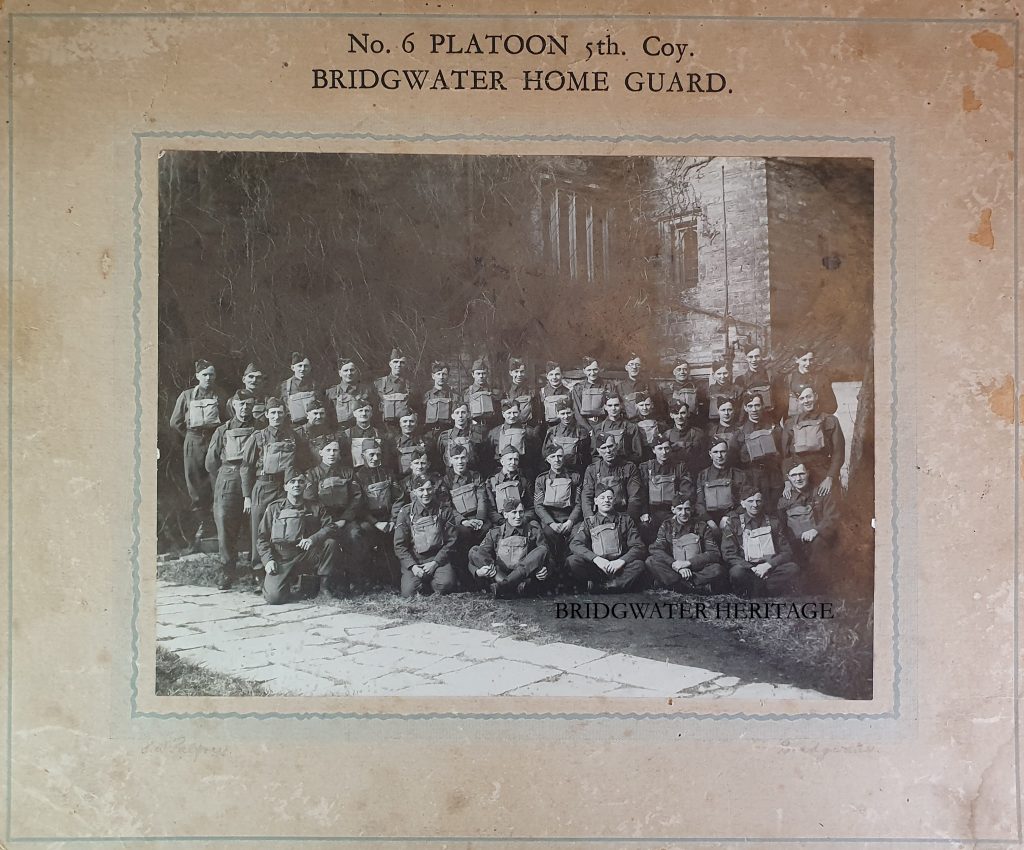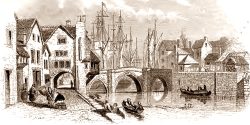The definitive book on the Somerset Home Guard is Jeffrey Wilson’s The Somerset Home Guard: A Pictorial Roll-Call (Millstream Books, 2004). That book is currently bring edited to incorporate information collected since the first issue so if anyone has any additional information please get in touch with Adrian Webb.
Sketch History
The formation of the Home Guard, initially known as the Local Defence Volunteers (LDV or popularly ‘parashooters’, i.e. shooters of the feared Nazi paratroopers), was announced nationally on 14 May 1940. British subjects aged 17 to 65 were asked to come forward to serve, on the understanding that this was a spare-time voluntary position and that they would continue their usual occupations. For men too young or old, or those in reserved occupations and unable to serve in the regular army, this was seen as an ideal way to serve in the war effort.
On 25 May 1940 the Taunton Courier and Western Advertiser reported that Brigader-General A.B. Incledon-Webber of Cannington had been appointed commander of the Bridgwater district section of the LDV. At the time around 300 men had joined from Bridgwater and some 300 more from the surrounding villages. The Bridgwater Company of this section was raised by Robert Chamberlin, a former captain of the regular army, who had served in the First World War and whose military career sent him to Waziristan (part of what is now Pakistan), Mesopotamia (Iraq) and Palestine (Taunton Courier and Western Advertiser, 23 September 1944). Many of those coming forward had served in the First World War. Incidentally, there had been a similar local defence force formed in that war, known locally as the ‘Silkworm’s, and you can read more about them in ‘Bridgwater and the First World War’.
In July the LDV were renamed the Home Guard. At this time Chamberlin was promoted to Lieutenant-Colonel and given command of the Bridgwater Battalion (presumably what was previously called the ‘section’, although for a time he was still just referred to as ‘captain’ in the local papers). In October 1940, the Bridgwater Home Guard was inspected by Field Marshal Lord Birwood, parading in Brewery Field. Birwood had been commander of the Australians at Gallipoli in the First World War, and some of the Bridgwater men in the Home Guard chatted with him about their service there (Taunton Courier and Western Advertiser, 19 October 1940).
This newspaper report from August 1941 gives some idea of the expectations of the guard:
BRIDGWATER O.C.’s APPEAL FOR RECRUITS
Lieutenant Colonel. Chamberlin, commanding officer of the Bridgwater Battalion Home Guard, has sent a letter to volunteers under his command making a personal appeal to them to ” keep on their toes,” attend Parades, and see that their ranks are kept up to full strength.
He makes this appeal in view of the statement of Major-General Lord Bridgeman. Director-General of the Home Guard, in his review of reports in recent exercises, that air-borne Invasion is not merely possible, it is as near certain as can be. It may be a preliminary to or coincident with a seaborne invasion; and it may happen on a very large scale and over a wide area far inland. There is no lack of confidence at the War Office in the Home Guards’ will and capacity to harass the Germans if they set foot over here, in the same way as the Russian guerillas are doing.”
“We have trained hundreds of men for the fighting Services.” says Col. Chamberlin. “More are being called up, and there will be gaps in our ranks unless recruits come forward.” Many men have not yet undertaken any defence work and as every willing man will be needed in the perilous times ahead, I ask each of you to make a special effort to enrol at least one recruit to be trained for whatever work we are called upon to do. I am most anxious to extend the usefulness of the Bridgwater Battalion.
“Try to make men realise that untrained service will be useless in an emergency, and it will be too late to rush to join the Home Guard or any other defence service then. As a member of the Home Guard a man will take part in organised and ‘effective defence.”
Enrolling in the Home Guard was compulsory in some circumstances, especially if deemed necessary by a National Service Officer. One man, Wilfred John Palmer, aged 42, a scrap metal sorter of East Quay, was sent to prison for refusing. Palmer gave no reason for refusing, and on being sentenced to prison he simply replied ‘that will be a change for me’ (Taunton Courier and Western Advertiser, 21 August 1943).
In December 1944 the Bridgwater Home Guard was disbanded, holding a stand-down parade in St Matthew’s Field, inspected again by Lord Birwood. R. Chamberlin, O.B.E., O.C., now also mayor of Bridgwater. The BBC arranged for a recording of the event. (Western Daily Press, 30 November 1944; Western Daily Press, 5 December 1944).
Chamberlin was awarded an OBE by the king in the birthday honours list of 1942 for his work organising the Home Guard.
Organisation
The Bridgwater force was the 10th Battalion of the Somerset Home Guard. For more extensive details, personnel information and anecdotes, see Jeffrey Wilson’s The Somerset Home Guard: A Pictorial Roll-Call.
The Battalion was divided into 8 Companies, which were then divided into Platoons, which were again divided into Sections.
No. ? Quantock Company
The Quantock Company included platoons for Nether Stowey, Cannington & Combwich, Stogursey and Spaxton. Within one of the platoons was a North Newton and Moorlands Section.
No. ? Polden (“P”) Company
The Polden Company had platoons for Pawlett and Cossington & Bawdrip, and presumably more.
?Possible Puriton Company
This included a platoon for Burtle.
Unidentified 4th Company
No. 5. Bridgwater Company
The Bridgwater Company had six platoons:
- No. 1 Platoon, was led by Colonel Tamlyn (Taunton Courier and Western Advertiser, 15 April 1944)
- No. 2 Platoon, was led by Edward Wills (later Mayor of Bridgwater – Taunton Courier and Western Advertiser, 15 April 1950)
- 1 Section and 3 Section were responsible for defending the Bristol Road area (, specifically the Leggar and Castle Fields)
- 2 Section and 4 Section were responsible for ‘Draw Bridge’ (Barham’s Yard and the Black Bridge)
- No. 3 Platoon
- No. 4 Platoon
- No.5 Platoon -Roger Evans gives no.5 as Cellophane Platoon and no.6 as Railway Platoon, although he possibly has these mixed up. The Railway Platoon were responsible for defending Somerset Bridge.
- No. 6 Platoon (Cellophane) Met at Sydenham Manor. Commanded by Major P.H. Bradbury (Taunton Courier and Western Advertiser, 16 December 1944)
- No. 7 Platoon
- No. 8 Platoon
- No. 9 Platoon
No.6 Sedgemoor Company
The Sedgemoor Company included platoons for Parchey, Burrowbridge and Westonzoyland Platoon
No. 7 Royal Ordinance Factory Company
No.8 Headquarters Company
No. 6 Platoon, 5th Company
This terrific photograph was donated to us by Matt Cawkwell, and is now deposited with the Blake Museum in Bridgwater

BACK ROW Ernie Moysie; Jim Talbot; Ivor Kingston; Bill Knight; Male; UNKNOWN; UNKNOWN; Len Kelly; Terry Sparkes; W. Kingston; Len Duddridge; UNKNOWN; Jack Andrews; Charles Maunder; Arthur Collins.
SECOND ROW: Farrer; W. Stevens; J. Denman; UNKNOWN; UNKNOWN; UNKNOWN; Sam Thomas; UNKNOWN; Roy Bryant; UNKNOWN; UNKNOWN; Phil Shannon; Bill Budd; Chilcott
THIRD ROW: UNKNOWN: Sergeant C. Cottrell; UNKNOWN; Sergeant Maurice Vinnicombe; Lieutenant Bradbury; Sargent Bert Squires; Sargent Stanley Williams; Corporal Ted Cave; Corporal Tom Picton.
FRONT ROW: Jim Gower; Lance Corporal Ron Spearing; Corporal M. Hooper; Corporal M. Jarvis; Corporal Jack Bodley; Lance Corporal S. Burge; UNKNOWN
MKP 18 January 2025
With thanks to John Boyland, Rachel Bywater, Lizzie Anne
